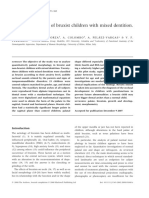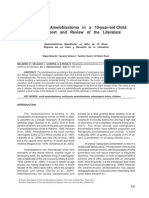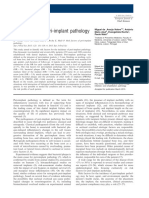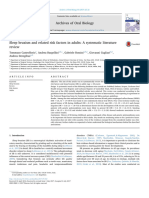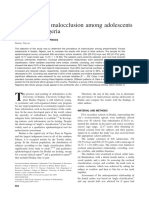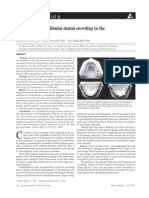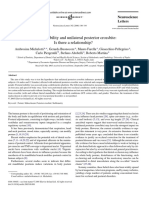A Method For Epidemiological Registration of Malocclusion
A Method For Epidemiological Registration of Malocclusion
Uploaded by
travolta0Copyright:
Available Formats
A Method For Epidemiological Registration of Malocclusion
A Method For Epidemiological Registration of Malocclusion
Uploaded by
travolta0Original Description:
Original Title
Copyright
Available Formats
Share this document
Did you find this document useful?
Is this content inappropriate?
Copyright:
Available Formats
A Method For Epidemiological Registration of Malocclusion
A Method For Epidemiological Registration of Malocclusion
Uploaded by
travolta0Copyright:
Available Formats
In his article on “Progress in th .
Hpidemiology ot’ 1kntal ( ‘arics,“ James
M. Dunning summarizes the subject a* follows:
“In a practical sense, dental caries is a multifactorial disease. 12 deliMe
balance of factors determines whether or not, disease will occur. This bala.nce
can often be manipulated to prevent dentul caries, even if the actual mechanism
or agent of the disease is not fully understood.
Multifactorial disease is best studied in groups of potentially susceptible
individuals, and epidemiology is the method of choice. There are four main
elements in the strat,egy of epidemiology. E’irst, data must be collected. Second,
hypotheses must be constructed. Third, observational studies must be conducted.
Finally, experiments or trials are necessary for clear proof of causation, or for
demonstration of the practicality of a preventive measure.”
Factors which influence dent,al caries are easily categorized into those related
to the host, those related to an agent, or those related to environment. Common
host factors are national or ethnic group, age, sex, familial heredity, emotional
disturbance, and nutrition. The “agent” of caries is perhaps best designated as
acid of bacterial origin, Two areas of environment may be considered-( 1) the
oral environment, which affects the external surfaces of the teeth, and (2)
the external environment, which affects the whole person. Local action of food-
stuffs and oral hygiene measures, with or without chemical protective agents,
provide the researchable questions for epidemiologic study in the oral environ-
ment. The external environmental factors are most easily grouped under
geographical, nutritional, and social headings. Geographically, the most severe
dental caries is seen nearer the poles and near the sea coast. Factors responsible
for these phenomena may include temperature, sunshine, relative humidity, and
distribution of natural fluoride in the water supply. Many nutritional factors
have been studied; among those that are known to be related t,o caries, fluoride
and carbohydrate most often dominate the scene. Major soil types may also
correlate with caries, but evidence is scanty. Social factors include economic
status (of importance only among very young children) and war.
In observational studies of caries, it is helpful t,o remember that severity
of disease determines the choice of measure to be used. J. -4. S.
A Method for Epidemiological Registration of Malocclusion
By A. Bjiirk, An. Krebs, and B. Solow. Acta odont. scandinav. 22: 27-41,
February, 1964.
The registration of malocclusions is divided into three parts:
A. Anomalies in the dentition (tooth anomalies, abnormal eruption,
and misalignment of individual teeth)
B. Occlusal anomalies (deviations in the positional relationship be-
tween the upper and lower dental arches)
C. Deviations in space conditions (spacing or crowding of teeth)
An indication of the need for orthodontic treatment is included in the
registration. This item cannot be recorded objectively in the same way as that
of the malocclusions, however, but must be based on an individual estimate.
-Volume 52 Reviews and abstracts 307
Number 4
Definitions of the various malocclusions and of the need for treatment used
in the registration procedure have been worked out on the basis of three pilot
studies, each on 100 children, and modified in the light of experience derived
from these studies. In order to evaluate the systematic errors of registration, the
examinations in one of these studies were performed by three dentists. In an-
other study the examinations were performed twice by the same dentist to
determine the random error of registration.
The occlusion is recorded. Incisal occlusion is judged from the most prom-
inent central incisor. Sagittal molar occlusion is evaluated with respect to the
mesial contact points of the upper and lower first permanent molars. Before
full eruption of the first permanent molars, the molar occlusion is determined
from the distal surfaces of the second deciduous molars. The position of the
third molars is disregarded in the registration of vertical and transversal
occlusion.
An account is given of a method for epidemiological investigation of the
prevalence of malocclusions. The method consists of a systematic registration of
carefully defined individual symptoms. The registration of some of the symptoms
is facilitated by using a specially designed instrument. The need for treatment
is also investigated, but this registration is subjective.
The study has been designed with a view to electronic analysis of the data.
The Bony Nasopharynx; a Roentgen-Craniometric Study
By Olav Bergland. Acta odont. scandinav. 21: Xupp. 35, 1963.
This article describes a study of the skeletal limitations of the nasopharynx
as a part of the cranium. The aim of the study was to investigate (I) variations
in the shape and size of this part of the skull and (2) its covariations with
cranial features which may influence the morphology of this region, primarily
the sagittal shape of the cranial base and the angles of the upper face.
The investigation comprised : (1) intragroup variations; (2) population
differences; (3) age changes (after about 6 years of age) ; (4) sex differences;
and (5) correlations.
Anatomically, the bony nasopharynx is bordered by the following skeletal
elements : (1) anteriorly, the structures constituting the choanal openings (the
medial plates of the pterygoid processes laterally and the dorsal border of the
vomer medially) ; (2) posteriorly, the pharyngeal surface of the body of the
sphenoid bone and of the basilar part of the occipital bone; (3) caudally, by the
posterior border of the horizontal part of the palatine bone anteriorly and by
the anterior margin of the foramen magnum posteriorly.
Geometrically, the bony nasopharynx in the median sagittal plane is shaped
like a gable. The anterior part of the gable, corresponding to the choanal struc-
tures, is formed by a line joining the landmarks staphylion (the posterior nasal
spine,) and hormion (the vomer’s dorso-rostra1 point of contact with the body
of the sphenoid bone). In man this line is approximately parallel to the main
direction of the pterygoid processes (the choanal plane).
The posterior part of the gable, corresponding to the caudal surface of the
You might also like
- Experimental Gingivitis in ManDocument11 pagesExperimental Gingivitis in ManCassia Martins PereiraNo ratings yet
- Middle School Choir Presentation Script HandoutDocument5 pagesMiddle School Choir Presentation Script Handoutapi-334651370100% (1)
- 11 - Facts and Myths Regarding The Maxillary Midline Frenum and Its Treatment A Systematic Review of The LiteratureDocument11 pages11 - Facts and Myths Regarding The Maxillary Midline Frenum and Its Treatment A Systematic Review of The Literaturekochikaghochi100% (1)
- Cysts of The Jaws in Pediatric Population: A 12-Year Institutional StudyDocument6 pagesCysts of The Jaws in Pediatric Population: A 12-Year Institutional StudyAndreas SimamoraNo ratings yet
- Caninos Impactados InferioresDocument9 pagesCaninos Impactados InferioresJORGE CARLOS MELGAR GUTIERREZNo ratings yet
- American Joumaz of Orthodontics: Original ArticlesDocument23 pagesAmerican Joumaz of Orthodontics: Original ArticlessiddarthNo ratings yet
- Metaanalysis of The Epidemiology and Clinical Manifestations of OdontomasDocument5 pagesMetaanalysis of The Epidemiology and Clinical Manifestations of Odontomasay lmaoNo ratings yet
- JIAP October 2011 - The Influence of Restorations and Prosthetic Crowns Finishing Lines On Inflammatory Levels After Non-Surgical Periodontal TherapyDocument8 pagesJIAP October 2011 - The Influence of Restorations and Prosthetic Crowns Finishing Lines On Inflammatory Levels After Non-Surgical Periodontal TherapyMedstudNo ratings yet
- Li Tiejun2006Document8 pagesLi Tiejun2006Herpika DianaNo ratings yet
- 24 475 1 PBDocument5 pages24 475 1 PBreal_septiady_madrid3532No ratings yet
- Aetiology and Severity of Gingival Recession in An Adult PopulationDocument7 pagesAetiology and Severity of Gingival Recession in An Adult Populationanon_958199921No ratings yet
- Palate Morphology Sleep Bruxism ChildrenDocument9 pagesPalate Morphology Sleep Bruxism ChildrenCamila Ignacia Diaz PaezNo ratings yet
- Bilateral Adenomatoid Odontogenic Tumour of The Maxilla in A 2-Year-Old Female-The Report of A Rare Case and Review of The LiteratureDocument7 pagesBilateral Adenomatoid Odontogenic Tumour of The Maxilla in A 2-Year-Old Female-The Report of A Rare Case and Review of The LiteratureStephanie LyonsNo ratings yet
- Medoralv24 I5 p562Document9 pagesMedoralv24 I5 p562katherineNo ratings yet
- Muller D.the Scoring of The Defects of The Alveolar Process in Human Crania.Document4 pagesMuller D.the Scoring of The Defects of The Alveolar Process in Human Crania.WellyAnggaraniNo ratings yet
- Facial AsymmetryDocument41 pagesFacial AsymmetryRahul GoteNo ratings yet
- Residentes AbrilDocument3 pagesResidentes AbrilLuis Zegarra SalinasNo ratings yet
- Bjorl: Clinical Diagnosis and Histological Analysis of Vocal Nodules and PolypsDocument7 pagesBjorl: Clinical Diagnosis and Histological Analysis of Vocal Nodules and PolypsRia Tupamahu MatatulaNo ratings yet
- Ameloblastic Fibroma: Report of A Case: Su-Gwan Kim, DDS, PHD, and Hyun-Seon Jang, DDS, PHDDocument3 pagesAmeloblastic Fibroma: Report of A Case: Su-Gwan Kim, DDS, PHD, and Hyun-Seon Jang, DDS, PHDdoktergigikoeNo ratings yet
- 05-Is Measurement of The Gingival Biotype ReliableDocument6 pages05-Is Measurement of The Gingival Biotype ReliableaemontoNo ratings yet
- Calcifying Epithelial Odontogenic Tumor - A Case Series Spanning 25 Years and Review of The LiteratureDocument10 pagesCalcifying Epithelial Odontogenic Tumor - A Case Series Spanning 25 Years and Review of The Literaturesyifa qushoyyiNo ratings yet
- Malocclusion Prevalence in An Ethnic Chinese PopulationDocument8 pagesMalocclusion Prevalence in An Ethnic Chinese PopulationLuis SarmientoNo ratings yet
- Global Distribution of Malocclusion Traits: A Systematic ReviewDocument10 pagesGlobal Distribution of Malocclusion Traits: A Systematic ReviewRoxana OneaNo ratings yet
- 100 103 PDFDocument4 pages100 103 PDFDanis Diba Sabatillah YaminNo ratings yet
- Woodworth1985 PDFDocument14 pagesWoodworth1985 PDFacevariel5851No ratings yet
- Mine 1Document55 pagesMine 1emeNo ratings yet
- 3 20291 YyyyyyyyyyyyyyDocument16 pages3 20291 YyyyyyyyyyyyyyNisa Nafiah OktavianiNo ratings yet
- Wjoud 2012 03 077Document10 pagesWjoud 2012 03 077shubhamtrivedi1711No ratings yet
- Orofacial Features of Treacher Collins SyndromeDocument6 pagesOrofacial Features of Treacher Collins SyndromeCarol Gissel FloresNo ratings yet
- Esclerosis TuberosaDocument4 pagesEsclerosis TuberosaJesus NietoNo ratings yet
- Multiple Simple Bone Cysts of The Jaws - Review of The Literature and Report of Three CasesDocument12 pagesMultiple Simple Bone Cysts of The Jaws - Review of The Literature and Report of Three CasesRodolpho VilelaNo ratings yet
- 1303 Prevalence and Etiologic Factors of Non Carious Cervical Lesions Among Prisons Population in DakarDocument6 pages1303 Prevalence and Etiologic Factors of Non Carious Cervical Lesions Among Prisons Population in DakarDHONY MIFTAHUL HUDANo ratings yet
- Mandibular Ameloblastoma in A 10-Year-Old Child: Case Report and Review of The LiteratureDocument6 pagesMandibular Ameloblastoma in A 10-Year-Old Child: Case Report and Review of The LiteratureWidhi Satrio NugrohoNo ratings yet
- De Araújo Nobre Et Al. - 2015 - Risk Factors of Peri-Implant Pathology-AnnotatedDocument9 pagesDe Araújo Nobre Et Al. - 2015 - Risk Factors of Peri-Implant Pathology-Annotatedandrea.lopez.pNo ratings yet
- Diagnostico de Las Asimetrias Faciales y DentalesDocument12 pagesDiagnostico de Las Asimetrias Faciales y DentaleslauraNo ratings yet
- Prevalence of Three-Rooted PrimaryDocument7 pagesPrevalence of Three-Rooted PrimaryBruno ArgemíNo ratings yet
- Craniofacial Asymmetry in Development: An Anatomical StudyDocument5 pagesCraniofacial Asymmetry in Development: An Anatomical Studyaprilla-dany-1630No ratings yet
- Dactyloscopy and RugosDocument4 pagesDactyloscopy and RugosJose Li ToNo ratings yet
- Cainos y Maduracion Esquleteal BaccettiDocument4 pagesCainos y Maduracion Esquleteal BaccettiPatricia BurbanoNo ratings yet
- Head Posture and Dental Wear Evaluation of Bruxist Children With Primary TeethDocument8 pagesHead Posture and Dental Wear Evaluation of Bruxist Children With Primary TeethEl GalenoNo ratings yet
- 08-The Heritability of Malocclusion-Part 2 The Influence of Genetics in Malocclusion PDFDocument9 pages08-The Heritability of Malocclusion-Part 2 The Influence of Genetics in Malocclusion PDFFadi Al Hajji100% (1)
- 333 FullDocument6 pages333 FullImara BQNo ratings yet
- Cystic Lesions of The Jaws A Retrospective ClinicopathologicDocument11 pagesCystic Lesions of The Jaws A Retrospective ClinicopathologicThành Luân NguyễnNo ratings yet
- Cat Ro Florio 2017Document8 pagesCat Ro Florio 2017Karen HamameNo ratings yet
- Maryam Alsadat Hashemipour 1 Most Impacted 3 M MBDocument6 pagesMaryam Alsadat Hashemipour 1 Most Impacted 3 M MBAlexandra CicaNo ratings yet
- s40510-015-0074-0 KavanackciDocument6 pagess40510-015-0074-0 KavanackciCarlos Miguel GarzotaNo ratings yet
- Prevalence of Malocclusion Among Adolescents in Ibadan, NigeriaDocument4 pagesPrevalence of Malocclusion Among Adolescents in Ibadan, NigeriaJose CollazosNo ratings yet
- Indicators of Mandibular Dental Crowding in The Mixed DentitionDocument5 pagesIndicators of Mandibular Dental Crowding in The Mixed DentitionDeepika KapoorNo ratings yet
- Case Report The Challenging Diagnosis of Primordial Odontogenic TumorDocument5 pagesCase Report The Challenging Diagnosis of Primordial Odontogenic Tumorlee zaraNo ratings yet
- Articulo GingivitisDocument18 pagesArticulo GingivitisRicardo Rojas CarreteNo ratings yet
- Indices PDFDocument10 pagesIndices PDFBhavikPatelNo ratings yet
- 90 CasosDocument5 pages90 CasosroomaarlopezsalgadoNo ratings yet
- Postural StabilityDocument5 pagesPostural StabilityLaura LealNo ratings yet
- Tumor Odontogenico EscamosoDocument4 pagesTumor Odontogenico Escamosoメカ バルカNo ratings yet
- 22q11.2 SyndromeDocument6 pages22q11.2 Syndromepopat78No ratings yet
- Cs LobodontiaDocument3 pagesCs LobodontiaInas ManurungNo ratings yet
- Ameloblastoma of The Jaws: A Retrospective Analysis of 340 Cases in A Malaysian PopulationDocument8 pagesAmeloblastoma of The Jaws: A Retrospective Analysis of 340 Cases in A Malaysian PopulationAmal BoualiNo ratings yet
- Estudi de Lesiones Katarzyna PDFDocument8 pagesEstudi de Lesiones Katarzyna PDFpaolaNo ratings yet
- Ultrasonic Topographical and Pathotopographical Anatomy: A Color AtlasFrom EverandUltrasonic Topographical and Pathotopographical Anatomy: A Color AtlasNo ratings yet
- Boyd, Robert - Treatment of Deep and Open Bite With Clear AlignersDocument27 pagesBoyd, Robert - Treatment of Deep and Open Bite With Clear Alignerstravolta0No ratings yet
- 37742Document13 pages37742travolta0No ratings yet
- My 5 Favorite EntriesDocument50 pagesMy 5 Favorite Entriestravolta00% (1)
- Innovator IBD® ETF Leaders ETF: Key PointsDocument2 pagesInnovator IBD® ETF Leaders ETF: Key Pointstravolta0No ratings yet
- Tads 3mDocument10 pagesTads 3mtravolta0No ratings yet
- Text SearchDocument11 pagesText Searchtravolta0No ratings yet
- Tads 1Document6 pagesTads 1travolta0No ratings yet
- Bisco One StepDocument4 pagesBisco One Steptravolta0No ratings yet
- Alliance Electronics LTD Plant Equipment Parts Catalogue 2018Document12 pagesAlliance Electronics LTD Plant Equipment Parts Catalogue 2018Alliance Transport Technologies Ltd100% (1)
- Kubernetes SecurityDocument156 pagesKubernetes Securitysalinob813No ratings yet
- Astm A956-22Document13 pagesAstm A956-22jesus.cwiengineerNo ratings yet
- TRUFORM EDGEFORM - Formwork - Guide - Aug12Document8 pagesTRUFORM EDGEFORM - Formwork - Guide - Aug12VINH TRANNo ratings yet
- 4 Issues That Kalimah At-Tawhid Confirms and RejectsDocument2 pages4 Issues That Kalimah At-Tawhid Confirms and RejectsTheEmigrantNo ratings yet
- Instant Download For Solution Manual For Managerial Accounting, 17th Edition, Ray Garrison, Eric Noreen Peter Brewer 2024 Full Chapters in PDFDocument68 pagesInstant Download For Solution Manual For Managerial Accounting, 17th Edition, Ray Garrison, Eric Noreen Peter Brewer 2024 Full Chapters in PDFhenangtinge100% (1)
- Laryngomalacia: Allison M. Dobbie,, David R. WhiteDocument10 pagesLaryngomalacia: Allison M. Dobbie,, David R. Whitewawa chenNo ratings yet
- Moonlight English Sample Y4 - 240925 - 083057Document57 pagesMoonlight English Sample Y4 - 240925 - 083057hadeelheadzNo ratings yet
- Structure: Pisces Amphibia, Reptilia, Aves Mammalia PoikilothermsDocument43 pagesStructure: Pisces Amphibia, Reptilia, Aves Mammalia PoikilothermsTapan Kumar PalNo ratings yet
- Post-Webinar Q&A On The Jinn Mentioned in The Qur'anDocument1 pagePost-Webinar Q&A On The Jinn Mentioned in The Qur'anSiyyid Adib LaganNo ratings yet
- Lecture Activity No. 3 Molecules of Plant Life ChekedDocument13 pagesLecture Activity No. 3 Molecules of Plant Life ChekedMatthew Reyes Remegia100% (1)
- Consent Form For SBIDocument2 pagesConsent Form For SBIannajoy natividadNo ratings yet
- Vilnius 2Document84 pagesVilnius 2Bogdan PretkielNo ratings yet
- Samrani Spring NL 2015Document4 pagesSamrani Spring NL 2015CornerStoneIntNo ratings yet
- In Ssssy: Dept: ECEDocument30 pagesIn Ssssy: Dept: ECEPhani KumarNo ratings yet
- 5 Axe HH Anglais VioletDocument29 pages5 Axe HH Anglais Violetyoyo mumbaNo ratings yet
- Print Media Past Present and Future ScenarioDocument43 pagesPrint Media Past Present and Future ScenarioVickesh MalkaniNo ratings yet
- Concept PaperDocument4 pagesConcept PaperAlexandra Rae100% (3)
- Harish Resume Work Exp RemovedDocument2 pagesHarish Resume Work Exp RemovedKarthik KakaNo ratings yet
- Adobe Scan 27 Jan 2024Document2 pagesAdobe Scan 27 Jan 2024kardinyenduNo ratings yet
- Integrated Farming SystemDocument6 pagesIntegrated Farming SystemMuddasir Ahmad Akhoon100% (1)
- Budget Example 1. House 200m2Document1 pageBudget Example 1. House 200m2ScribdTranslationsNo ratings yet
- Classificação PETROBRASDocument14 pagesClassificação PETROBRASLeonan CostaNo ratings yet
- Sophia ResumeDocument3 pagesSophia Resumeapi-490261745No ratings yet
- Urs For Erp Ex 2Document37 pagesUrs For Erp Ex 2AbhijeetNo ratings yet
- Metasploitable Exploits and Hardening GuideDocument10 pagesMetasploitable Exploits and Hardening GuideelmaestrosbokNo ratings yet
- Energy Flow Worksheet 2019: What Is An Ecosystem?Document7 pagesEnergy Flow Worksheet 2019: What Is An Ecosystem?api-254994380No ratings yet
- 2024 TEACHER NEED ANALYSIS TEMPLATE-blankDocument65 pages2024 TEACHER NEED ANALYSIS TEMPLATE-blankElmer EstuistaNo ratings yet
- Transfer Information DocumentDocument2 pagesTransfer Information Documentshahzeel khanNo ratings yet











